"I visited the railway line. We see the potential of the project, but also the need to develop an ecosystem. It's not just about transportation, it's about developing agro-industries, and seeing how we can integrate with the Democratic Republic of the Congo and Zambia," said Axel van Trotsenburg.
In an interview with Lusa at the end of his visit to Angola this week, the World Bank's number two said the visit "was very encouraging" and added: "We suggest creating an economic ecosystem that takes advantage of the potential of the continental free trade area (AfCFTA) and, in a way, gains momentum in growth through the integration of economies."
One aspect of this project, which essentially consists of rehabilitating the railway line that runs from the port of Lobito to the border with the Democratic Republic of the Congo for the transportation of minerals, is the need to rehabilitate passenger transport.
"This will provide new connectivity opportunities along the railway, which could include tourism and investment opportunities, particularly given the deep-water port, which is very favorably located," said the World Bank director.
Asked whether the Angolan government is committed to creating agro-industries around the central mineral transport line from the Democratic Republic of the Congo to Lobito, Axel van Trotsenburg responded: "In discussions with the government and with local authorities, this expanded corridor concept is very much on their minds."
The Lobito Corridor is a 1300-kilometer railway that crosses Angola, connecting the coastal port of Lobito to the border with the Democratic Republic of the Congo to transport critical mineral production from the Copperbelt (DRC) and Kolwezi (Zambia) regions.
The operation is operated by Lobito Atlantic Railway (a consortium comprising the Portuguese company Mota-Egil, the Swiss company Trafigura, and the Belgian company Vecturis), and is expected to have a investment of almost one billion dollars, partially financed by the North American financing agency Development Finance Corporation (DFC) and the Development Bank of Southern Africa, in addition to the European Union and multilateral banks involved in the project.







